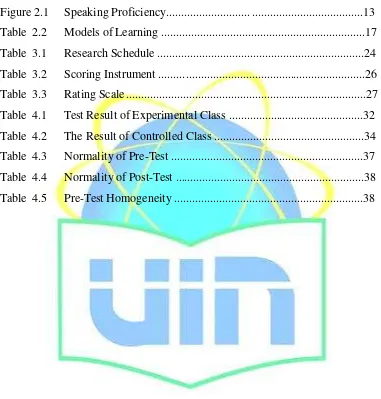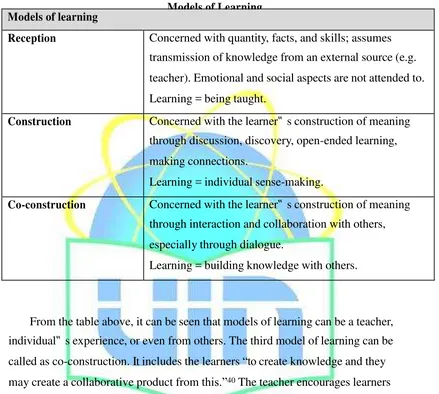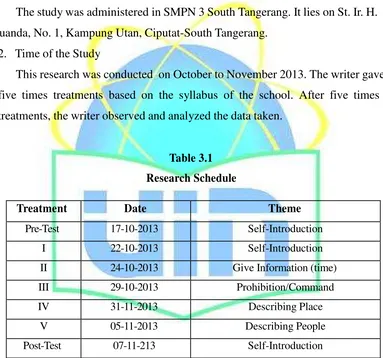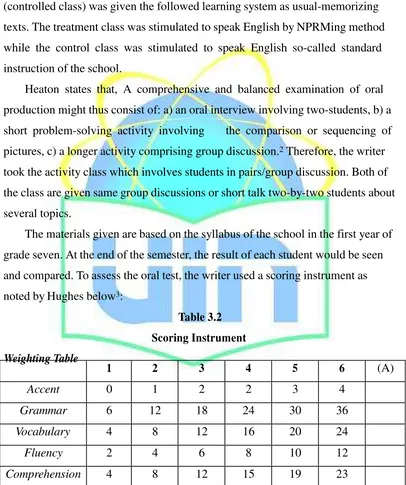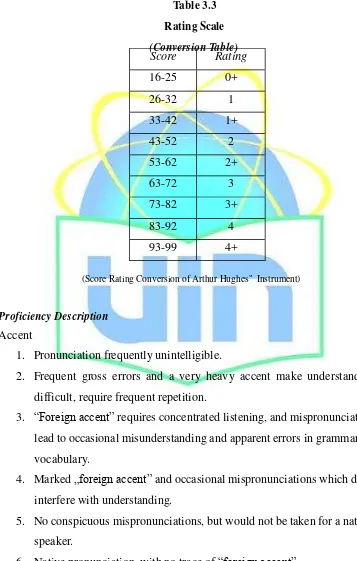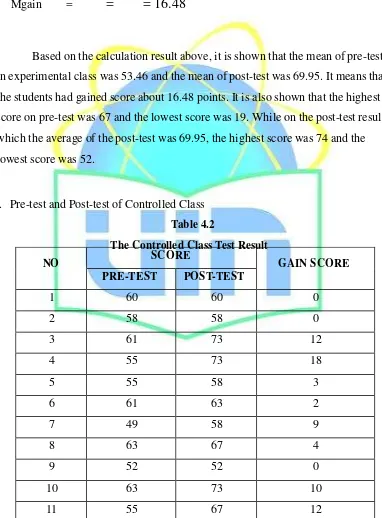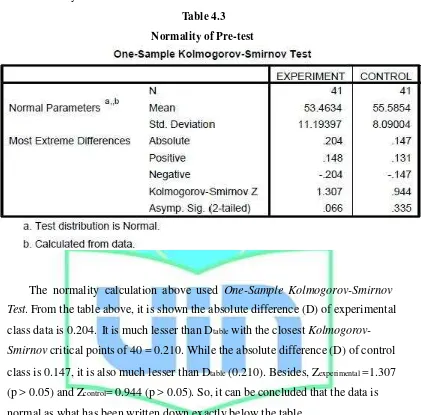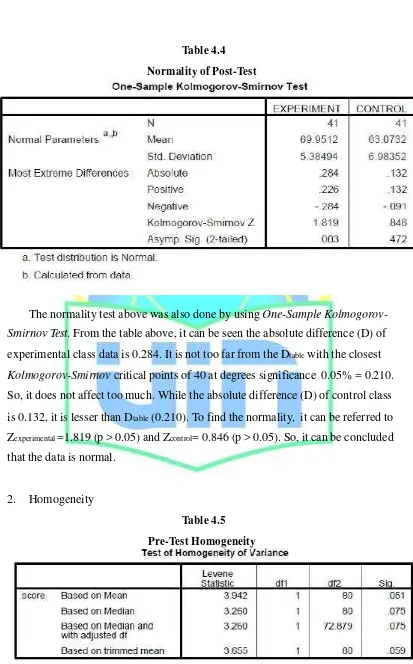THE
EFFECTIVENESS
OF
USING
NEAR-PEER
ROLE
MODELING
(NPRM)
ON
STUDENTS’
SPEAKING
ABILITY
(AQuasi-ExperimentalStudyattheFirstGradeofSMPN3SouthTangerang)
By
NURLAILAINDAHJ.
NIM.109014000148
THE
DEPARTMENT
OF
ENGLISH
EDUCATION
FACULTY
OF
TARBIYA
AND
TEACHERS
TRAINING
SYARIF
HIDAYATULLAH
STATE
ISLAMIC
UNIVERSITY
JAKARTA
2014
ABSTRACT
NurlailaIndahJ.(Reg.No.109014000148).TheEffectivenessofUsing Near-Peer Role Modeling (NPRM) on Students’ Speaking Ability (A Quasi-ExperimentalStudyattheFirstGradeofSMPN3SouthTangerang).Skripsiof FacultyofTarbiyaandTeachersTrainingofSyarifHidayatullahStateIslamic UniversityJakarta,2014
Keywords: Speaking,Near-PeerRoleModeling,Motivation,SelfEfficacy.
SpeakingskillhasbeenoneofthemostwantedskillsinEnglishlearning today.Therefore,speakingwasthefocusoftheresearch.Thewriteradministered aresearchbyapplyingamethodnamedNear-PeerRoleModeling(NPRM)inthe firstgradeofSMPN3SouthTangerang.Thepurposeofthestudywastogetthe empirical data which can describe whether Near-Peer Role Modeling was effective or not in enhancing students’ speaking competence in English. This studyusedaquantitativemethodwithaquasiexperimentalstudydesign.This studywasheldonOctoberuntilDecember2013.Thesamplingtechniqueusedin theresearchwassimplerandomsampling.Thereforethewritertooktwoclasses forbeingthesubjectoftheresearch;oneforexperimentalclassandanotherfor thecontrolledclass.Thedatawereanalyzedbyusingt-testformula.Thedata found indicated that there was a significance difference between students in experimentalclassandcontrolledclass.Theresultoft-testformulain5%degree ofsignificanceshownthattobserved(t0)>ttable(tt)=7.05>1.99. So,thenull
hypothesis(H0)isrejectedandalternativehypothesis(Ha)isaccepted.Itmeans
that,therewasasignificantdifferencebetweenstudentsusingNPRMandthose whodidnot.ThestudentswhoweretaughtbyNPRMcanattainbetterspeaking scorethanthestudentswhowereonlytaughtbymemorizingtextwhilespeaking. Inotherwords,theNPRMiseffectivetobeappliedinSMPN3SouthTangerang.
ABSTRAK
NurlailaIndahJ.(NIM.109014000148).KeefektivanPenggunaanNear-Peer Role Modeling terhadap Kemampuan Berbicara Siswa (Sebuah Penelitian Kuasi-ExperimentaldikelasVII,SMPN3TangerangSelatan)Skripsi,Jurusan PendidikanBahasaInggris,FakultasIlmuTarbiyahdanKeguruan,Universitas IslamNegeriSyarifHidayatullahJakarta,2014.
KataKunci: Berbicara,Near-PeerRoleModeling,Motivasi,SelfEfficacy.
Keterampilanberbicaratelahmenjadisalahsatuketerampilanyangpaling dicari dalam pembelajaran bahasa Inggris sekarang ini. Maka dari itulah, keterampilanberbicaramenjadifokusdalampenelitianini.Penulismengadakan sebuah penelitian dengan mengaplikasikan metode bernama Near-Peer Role Modeling(NPRM)dikelasVII,SMPN3SouthTangerang.Tujuandaripenelitian initidaklainadalahuntukmendapatkandataempiris yangdapatmenjelaskan bahwaNPRMituefektifatautidakdalammeningkatkankemampuanberbicara siswa dalam bahasa Inggris. Penelitian ini menggunakan metode kuantitatif dengandesainquasiexperimental.PenelitaninidilaksanakanpadabulanOktober hingga Desember 2013. Pengambilan sampel yang digunakan penulis adalah dengantekniksampelacaksederhana.Makadariitupenulismengambilduakelas sebagai subjek penelitian; satu merupakan kelas eksperimen dan yang lainnya merupakan kelas kontrol. Data yang diperoleh dianalisa dengan menggunakan rumust-test.Datatersebutmengindikasikanbahwaadaperbedaan yangcukup signifikanantarakelaseksperimendankelaskontrol.Hasildariujit-testpada tarafsignifikansi5%tersebutmenunjukkanbahwattes(t0)>ttabel(tt)=7.05>1.99.
Makahipotesisnull(H0)ditolakdanhipotesisalternative(Ha)diterima.Halini
berarti ada perbedaan yang cukup signifikan antara murid yang menggunakan NPRMdanmuridyangtidakmenggunakanNPRM.Muridyangdiajarkandengan metode NPRMdapatmeraihnilaispeakingyanglebihbaikdaripadamuridyang hanya diajarkan dengan metode menghapalkan teks. Dengan kata lain, NPRM efektifuntukditerapkandiSMPN3TangerangSelatan.
ACKNOWLEDGEMENT
IntheNameofAllah,theMostGracious,theMostMerciful
PraisedbetoAllah,Lordoftheworlds,WhohasgiventhewriterHislove
andcompassiontofinishthelastassignmentinherstudy.Peaceandsalutationbe
upontotheprophetMuhammadPBUH.,hisfamilyandhiscompanion.
Itisapleasuretoacknowledgethehelpsandcontributionsofalllecturers,
institution,family,andfriendswhohavecontributedindifferentwayshencethis
skripsiwasprocesseduntilitiscompletedandpresentedtotheFacultyofTarbiya
andTeachersTrainingasapartialfulfillmentoftherequirementsforthedegreeof
S.Pd.(BachelorofArts)inEnglishLanguageEducation.
Firstofall,thewriterwouldliketoconveyherspecialgratitudetoher
advisors,DR.AtiqSusilo,MAandAtikYuliyani,MA.TESOL,whosescholarly
suggestionsandcriticalremarkshaveenabledthewritertorefinethisskripsi.A
specialgratitudeisalsoconveyedforherbelovedparents,Mr.SigitJatmikoand
Mrs.PujiAstutiwhohavegiventheirinfinitelove,care,supports,andhelps.The
writerbelievesthatitisalmostimpossibletofinishthisskripsiwithoutthemby
herside.
Thewriter’ssinceregratitudealsogoesto:
1. AllofthelecturersofEnglishEducationDepartment
2. Drs.Syauki,M.Pd.,theHeadofEnglishDepartment
3. H.Maryono,SE.,M.M.Pd.,theHeadofSMPN3SouthTangerang
4. Agit Pratroris Nugraha, S.Pd., the English Teacher of SMPN 3 South
Tangerang
5. ZaharilAnasy,M.Hum.,theSecretaryofEnglishDepartment
6. Dra. Nurlena, MA., Ph.D., the Dean of the Faculty of Tarbiya and
TeachersTrainingSyarifHidayatullahStateIslamicUniversityJakarta
7. NidaHusna,M.Pd.,MA.TESOL,theacademicadvisor
8. AllofherbelovedfriendsatSMAN1Purwakarta,D-Class2009Syarif
Hidayatullah State Islamic University, KMM RIAK (Komunitas Musik
Mahasiswa-RuangInspirasiAtasKegelisahan),andeverybodywhocannot
bementionedonebyone, thanks for givinghappiness when she feels
bored,thankyoufornicebrotherhoodandsisterhood
The writer does realize that this skripsi cannot be considered perfect
withoutcritiquesandsuggestions.Therefore,itissuchapleasureforherto
getcritiquesandsuggestionstomakethisbetter.
Jakarta,January27th2014
TheWriter
TABLE
OF
CONTENT
TITLE... i
SURATPERNYATAANKARYAILMIAH... ii
APPROVALSHEET... iii
ENDORSEMENTSHEET... iv
ABSTRACT... v
ABSTRAK... vi
ACKNOWLEDGEMENT... vii
TABLEOFCONTENTS... ix
LISTOFFIGUREANDTABLES... xi
LISTOFAPPENDICES ... xii
CHAPTERI INTRODUCTION ...1
A.BackgroundofStudy...1
B.LimitationoftheProblem...3
C.ProblemsFormulation...4
D.PurposeoftheStudy...4
E.ObjectiveoftheStudy...4
CHAPTERII LITERATUREREVIEW...5
A.Speaking...5
1.TheUnderstandingofSpeaking...5
2.PurposeofSpeaking...5
3.KindsofSpeakingActivities...6
4.ElementsofSpeaking...7
a.Grammar...7
b.Pronunciation...9
c.Vocabulary... 10
B.SpeakingAbility... 12
C.TeachingSpeaking... 14
1.TeachingSpeakingEnglishasaForeignLanguage... 14
2.GoalofEnglishTeachinginIndonesia... 15
D.NearPeerRoleModeling... 16
1.TheUnderstandingofNear-PeerRoleModeling... 16
2.BenefitsofNear-PeerRoleModeling... 20
3.TheApplianceofNear-PeerRoleModeling... 20
E.PreviousStudy... 20
F.ConceptualFramework... 22
G.TheoreticalHypothesis... 23
CHAPTERIII RESEARCHMETHODOLOGY... 24
A.PlaceandTimeoftheStudy... 24
B.ResearchMethodandDesign... 24
C.PopulationandSample... 25
D.ResearchInstrument... 25
E.DataAnalysisTechnique... 29
F.StatisticalHypothesis... 31
CHAPTERIV RESEARCHFINDINGSANDDATA INTERPRETATION... 32
A.ResearchFindings... 32
1.DataDescription... 32
a. Pre-testandPost-testofExperimentalClass... 32
b.Pre-testandPost-testControlledData... 34
2.DataAnalysisandHypothesisTesting... 36
a. AnalysisofPre-testandPost-test... 36
b.HypothesisTesting... 39
B. DataInterpretation... 41
CHAPTERV CONCLUSIONANDSUGGESTIONS... 43
A.Conclusion... 43
B.Suggestions... 43
REFERENCES... 45
APPENDICES... 48
LIST
OF
FIGURE
AND
TABLES
Figure2.1 SpeakingProficiency...13
Table 2.2 ModelsofLearning...17
Table 3.1 ResearchSchedule...24
Table 3.2 ScoringInstrument...26
Table 3.3 RatingScale...27
Table 4.1 TestResultofExperimentalClass...32
Table 4.2 TheResultofControlledClass...34
Table 4.3 NormalityofPre-Test...37
Table 4.4 NormalityofPost-Test...38
Table 4.5 Pre-TestHomogeneity...38
[image:11.595.113.494.165.564.2]LIST
OF
APPENDICES
1. SKKDofFirstGradeofJuniorHighSchool...48
2. LessonPlans ...51
3. Materials...78
4. IntervalGroupforHypothesisTesting...88
5. TheCriticalValueofT...89
6. SuratKeteranganSMPN3SouthTangerang...90
7. ScheduleofSMPN3SouthTangerang...91
8. PengesahanProposalSkripsi...92
9. SuratPermohonanIzinObservasi...93
10. SuratPermohonanIzinPenelitian...94
11. SuratBimbinganSkripsi...95
CHAPTER
I
INTRODUCTION
A.
Background
of
the
Study
TherehavebeenmanywaystoteachEnglish.Itstartedinthelatenineteenth
century,whenlinguistandlanguagespecialistwantedtoimprovethequalityof
language teaching. As stated by Richards and Rodgers, “In the mid-and late
nineteenth century opposition to Grammar-Translation Method gradually
developed in several European countries. This Reform Movement, as it was
referredto,laidthefoundationsforthedevelopmentofnewwaysofteaching
languagesandraisedcontroversiesthathavecontinuedtothepresentday.”1
TomakestudentsunderstandandhavegoodcompetenceinEnglish,itis
neededagoodtheoryofhowalanguageshouldbetaughtandlearnt.Therefore,
newmethodsweredevelopedtostudyEnglishbyreferringtogeneralprinciples
andtheoriesconcerninghowlanguagesarelearnt,howknowledgeoflanguageis
representedandorganizedinmemory,orhowlanguageitselfisstructured.
Somehow a good method will focus not only on the rethoric aspect of
knowledge but also the psychological aspect of the students when they are
learninganewlanguage.Languageskillswhicharedevelopedassomebodystarts
learninganewlanguagearespeaking,listening,reading,andwriting.Tohave
thoseskills all at once maynot be easy. Hence, therehas to be an effective
teaching and learning English based on the goal. Nowadays, the focus in
conventionalmodernlanguageteachinghasbeenonthelanguagefunctionitself.
Languageisusedtocommunicateeachother.So,itisneededagoodmethod
whichhelpstudentstoinitiateinspeakingEnglishandimprovetheirskillsin
speakingEnglish.Itcombinestheaspectofknowledge,social,andpsychology.
Thenstudentscanbemotivatedtokeeplearninganddoingmoreimprovement.
The goal ofmodernlanguageteachingis students arerequired to have a
communicativecompetence.Communicativecompetencereferstothelanguage
1 Jack C. Richards and Theodore S. Rodgers, Approaches and Methods in Language Teaching,1sted.,(Cambridge:CambridgeUniversityPress,1986),p.5.
2
user'sgrammaticalknowledgeofsyntax,morphology,phonologyinEnglishand
indeed the social knowledge of how and when the utterances should be used
appropriately. Unfortunately in Indonesia, English is onlytaught as a foreign
language.Therefore,studentsarenotreallyforcedtospeakinEnglishasinother
countriesofESL(EnglishasSecondLanguage).Astheconsequence,students
willnothavegoodcircumstancestolearnEnglisheffectively.
Unfortunately,alotofproblemsfoundinstudentstospeakEnglishinEFL
country.StudentswhoarenotinEnglishspeakingcountryareusuallyafraidto
startspeakingEnglishbecausetheyfeellackofvocabulary,ormakingmistakes
anderrorswhilespeaking.Therefore,theyarenottryingtospeakEnglish.To
makestudentsinitiatetospeakEnglishandhaveagoodskillinspeaking,itneeds
morethanjustgivingstudentsalotofwordstorememberortensesbasedonits
context.Asinfact,speakingskillcanonlybeachievedbyspeakingtrainingandit
isnotaninstantwork.
Moreover,whenattemptingtospeak,learnersmustgathertheirthoughtand
encodetheideasinthevocabularyandsyntacticstructuresofthetargetlanguage
(English).Inthiscase,speakingskillissomehowassociatedtothemotivationof
thestudentsthemselves.Besides,thechallengeneedstobefacediswhenstudents
whoareinterestedinEnglishgettheirenthusiasmdisappearsoverthetime,some
are caused of learning foreign language need hard work, some are caused of
Englishdoesnotseemimmediatelyusefulorrelevanttotheirlives,andsomeare
causedofthechancetousetheskillshavebeenlearntisnull.Motivationcan
reallyinfluenceonstudyingnewthingsandthereviewperformanceofmaterials
whichhavebeenlearnt,tactics,andmanners.2
ItisNear-PeerRoleModeling,amethodwhichemergesfromanunderlying
principlethatpeerscanbeatrustedandcrediblesourceofinformation.Thepeers
cansharesimilarexperiencesandsocialnorms.Itencouragesstudents’interaction
duringtheclassundertheinfluenceoftheclosepeertouseEnglishsuccessfully.
Usingapeermodeltodeliverinformationtostudentscanensurethateachof
3
peerscantakeanequalroleininforming,shaping,andpassingoninformation.
Near-PeerRoleModelingisassumedtobeabletoincreasestudents'motivation
andstrategy-choicewhiledaringtobeliefin studyingEnglish. Itis amethod
whichmoregivesfocus onthepsychologicalaspectofstudentsinlearninga
language,especiallyinspeakingEnglish.
Furthermore based on writer’s findings on preliminary study in SMPN 3
South Tangerang, it was found that students were afraid to start speaking in
English.Theyusuallyfeltdoubttotryspeakingaslackingofvocabularythough
theteacherhadencouragedthemtospeak.Studentswereusuallyforcedtospeak
inaplannedconversation.Theyusedtotakeaconversation/dialoguefrombooks
tobememorizedandpracticed.Infact,speakingskillcanalsobeattainedfrom
workingoutEnglishinreallifefromcertaintopicsrelatedtothesubjectmaterial.
Fromthisproblem,itisquiteobviousthatstudentsmightneedamodelwhichcan
givethemmoreself-efficacyandmotivation.Apeermodelcandefinitelygivea
positive influence to the students as “seeing or visualizing people similar to
oneselfperformsuccessfullytypicallyraisesefficacybeliefsinobserversthatthey
themselvespossessthecapabilitiestomastercomparableactivities.”3Therefore,
as well as Near-Peer Role Modeling, it can overcome the problems faced by
studentswhentheywanttospeakup.
AsteachingmethodofEnglishcanaffectstudents’competenceinEnglish,
thewriterwaseagertotakethisproblemasherresearch. Thewritertriedto
stimulate students to speak English byusing Near-Peer Role Modeling-where
studentscouldtrytospeakfreelywithoutfeelinganxiousofmakingmistakes.
Thewriterconductedaresearchon“TheEffectivenessofUsingNear-PeerRole
Modeling(NPRM)onStudents’SpeakingAbility”.
B.
Limitation
of
the
Problem
Alloftheproblemshappenedabovemightconsumetoomuchtimetobe
researchedallatonce.Duetotheproblemsfacedaretoowide,thewriteronly
3TimMurphey,SelfandOtherModeling:StreghteningImaginedIdealSelvesforStudents
4
focusedononeproblem.ThewriterfocusedtheresearchontheEnglishteaching
methodwhichishopefullywillincreasestudents’motivationandself-efficacyby
usingNear-PeerRoleModelinginoralcompetencies.
C.
Problems
Formulation
Basedonthebackgroundabovethewriterformulatedtheresearchquestions
asfollows:
1. IsNear-PeerRoleModeling(NPRM)effectiveonstudents’speakingability
inEnglish?
D.
Purpose
of
the
Study
The purpose of the study was to get empirical evidence about the
effectivenessofusingNear-PeerRoleModeling(NPRM)onstudents’speaking
abilityinEnglish.
E.
Objective
of
the
Study
The results of the study are expected to give information for teachers,
especiallyEnglishteachersinJakartawhetherNear-PeerRoleModelingsupports
CHAPTER
II
LITERATURE
REVIEW
A.
Speaking
1. TheUnderstandingofSpeaking
McDonoughandShawstates,“Speakingisnottheoralproductionofwritten
language,butinvolveslearnersinthemasteryofawiderangeofsub-skillswhich,
addedtogether,constituteanoverallcompetenceinthespokenlanguage.”1So,it
means that speaking is an activity which involves several sub-skills such as
pronunciation,grammar,andvocabulary.
Speaking is a productive skill that involves genuine exchange of
information.2Itmeansthatspeakingisanactivitywhichproducessomething,in
thiscasewordstoshareinformation.WhileaccordingtoTarigan,“Speakingisan
ability to say sounds, articulation, or words to express, convey, or deliver
thoughts,ideas,andfeelings.”3Therefore,speakingisdeterminedasaskillwhich
dealsthewayofpronouncingwordsandgiveinformationfromthespeaker‟ sside
whetheritistheideas,thought,orevenfeelings.MoreoverTariganenforcesthat
speakingisbeyondutteringwordsormakesounds.Itiscalledas“aninstrument
tocommunicateideaswhicharearrangedanddevelopedaccordingtotheneedsof
listener or hearer.”4 Through speaking, human can converse each other. To
conclude,speakingcanbedefinedasanactivitywhich enactiveseveralskills
such as knowledge of vocabulary, pronunciation, and grammatical features to
encodeandexpressanoralideaforaccomplishingapurpose.
2. PurposeofSpeaking
Speaking also refers to a desire which enables people to produce certain
wordsinapurpose.ItissupportedbyMcDonoughandShawwhostates:
1
McDonough and Christopher Shaw, Materials and Methods in ELT-A Teacher’s Guide, (Oxford:Blackwell,1993),p.151.
2Swaminatha Pillai, English Language Teaching-First Year, (Chennai: Tamilnadu
Corporation,2008),p.106.
3Henry Guntur Tarigan, Berbicara Sebagai Suatu Keterampilan Berbahasa, (Bandung:
Angkasa, 2008), p. 16.
4Ibid.
6
As a skill to produce utterances, when genuinely communicative, speaking is desire and purpose driven, in other words we genuinely want to communicate
somethingtoachieveaparticular end.Thismayinvolveexpressingideas,opinions,
expressingawishoradesiretodosomething;negotiatingand/orsolvingaparticular
problem;orestablishingandmaintainingsocialrelationshipsandfriendship.5
WhitmanandBoasenotesthatthefunctionofspeaking(publicspeaking)are
to interest, to entertain, to inform, to inquire, to persuade, to convince, to
stimulate,todenounce,toimpress,towarn,toarouse,toinstruct,toexplore,to
move,andtoconfuse.6WhileaccordingtoTarigan,speakinghasthreegeneral
purposes:a)toinform,b)toentertain,andc)topersuade.7Eventhemixtureof
thosethreeintoonepurposeisalsoapossibility.
ItisalsosupportedbyBoerthattherearethreegeneralpurposesofspeaking:
a)Toinform,thespeakergivesthehoworwhatofatopic,withanaimofgetting
thelistenerinbelievingsomething.b)Topersuade,thespeakergivesthewhy,
withanaimofgettingthelistenerstodosomething.c)Toentertain,onlygiving
thelistenersanenjoyment.8Thosegeneralpurposesareallbasedonwhatthe
speaker wants to do with their words to other people. It can informative,
persuasive,orevenentertaining.
3. KindsofSpeakingActivities
AccordingtoSnow,inaprocessofproducingasentenceinEnglish,students
needtostrugglewiththegoalofspeakingidea,strategy,listener‟ sbackground
knowledge, word choice, grammar, pronunciation, and gestures and facial
expression.ThereareseveralclassesactivitiescanbedoneinteachingEnglishas
follows:
a. Memorization of material, students are encouraged to speak by
memorizingsomepassagesordialogues.
b. Choraldrill,theall-classrepeatwhattheteachersays.
5McDonoughandShaw,op.cit.,p.152.
6Yayan G. H. Mulyana, A Practical Guide for Public Speaking, (Bekasi: Kesaint Blanc,
1995),pp. 2─3.
7
Tarigan,op.cit.,pp. 16─7.
8John J. Boer, Basic Language Messages and Meanings, (New York: Harper & Row
7
c. Classroom chat, it is the informal communication which is more fun,
nonthreatening,andlikeamodelofgenuinecommunication.
d. Model-based dialogues, using a dialogue in a textbook and act the
dialoguewiththemovesthatillustratethedialogue.
e. Presentations,studentsprepareandpracticematerialwithinitsgrammar,
vocabulary,pronunciation,andintonationinfrontoftheclass.
f. Roleplays,pairpracticeoffreedomtoplay,improvise,andcreatearole.
g. Survey,askingthesamefewquestionsseveraltimestodifferentstudents.
h. Interviews,converseingreaterdepthwithapair.
i. Cocktailparties,anendlesstalkwithapersonandclosetheconversation,
thenmoveonforsomechatwithanotherperson.
j. Pairorsmall-grouptasks,studentsworktogetherinpairsorgroupwitha
tasktodeal.
k. Debates,arguewithanissueandthereisonlyonepersoncangiveanidea
atatimeindebatephase.
l. Large-group discussion, it can arise students‟ interest in topic about
something.9
4. ElementsofSpeaking
a. Grammar
Grammaristhesetofstructuralrulesthatgovernsthecompositionofclauses,
phrases,andwordsinanygivennaturallanguage.10So,grammarisalanguage
rule considering the pattern of words/sentences. While according to Yule
grammaris,“theprocessofdescribingthestructureofphrasesandsentencesin
suchawaythatweaccountforallgrammaticalsequencesinalanguageandrule
outalltheungrammaticalsequenceisonewayofdefininggrammar.”11Itmeans
thatgrammarisallaboutthefeaturesoflanguagestructure.Besides,Kollnand
9DonSnow,FromLanguageLearnertoLanguageTeacher,(Virginia:TeachersofEnglish
toSpeakersofOtherLanguages,Inc.,2007),pp. 108─17.
10Grammar,(http://en.wikipedia.org/wiki/Grammar),January13,2014.
81.
8
Funkstatesthatgrammarrefersto:a)thesystemofrulesinourheads,b)the
formaldescriptionoftherules,c)thesocialimplicationsofusage,sometimes
called „linguisticetiquette‟ .12 Thus, grammarcan bedefined as astudyabout
knowing to produce any sentences subconsciously in mind, the branch of
linguisticsscience,andmannersofdailyusageoflanguage.
Englishgrammaticalfeaturesconsistofseveralrulessuchas:verbtenses,
partofspeech,wordclassorder,andsentence/clausepattern.Englishtensesare
classifiedintothree-present,past,andfuture.Presenttensesareusedtoshowthe
dailyactivities.Pasttensesareusedtoshowtheactivitiesinpasttime.While
futuretensesareusedtoexpresstheactivitieswhicharegoingtodoinfuture.
Whilepartofspeecharethewordclasses.Thereareeightkindspartofspeech.It
canbeseenasbelow.
Nouns, words used to refer to people, object, creatures, qualities,
phenomena,andabstractideas.(e.g.boy)
Articles,wordsusedwithnounstoformnounphrasesoridentifyingthe
thingsalreadyknown.(e.g.a/the)
Adjectives,wordsusedtypicallywithnouns,toprovidemoreinformation
aboutthethingsreferred.(e.g.happy)
Verbs,wordsusedtorefertovariouskindsofactionsandstatesinvolving
peopleandthingsinevents.(e.g.talk)
Adverbs,wordstypicallywithverbs,toprovidemoreinformationabout
actions,states,event.(e.g.slowly,yesterday)
Prepositions, words used with nouns in phrases providing information
abouttime,place,andotherconnectorsinvolvingactionsandthings.(e.g.
at,in)
Pronouns, words used in place of noun phrases, typically referring to
peopleandthingsalreadyknown.(e.g.it,herself)
12
MarthaKollnandRobertFunk,UnderstandingEnglishGrammar,8thed.,(NewYork:
9
Conjunctions,wordsusedtomakeconnectionsandindicaterelationships
betweenevents.(e.g.and,because)13
b. Pronunciation
Pronunciationisthewayawordoralanguageisspoken,orthemannerin
which someone utters a word.14 The study of how a language should be
pronouncedisphonology.Phonologyis“essentiallythedescriptionofthesystem
andpatternsofspeechsoundsinalanguage.”15TopronounceEnglishwordsto
some people may be quite difficult. Speech sounds are made by air moving
outwardfromthelungsthroughthemouthornose.16Itiscausedofthedifferent
mannerofpronouncingtheirfirstlanguageandEnglishlanguage.Englishwords
soundedunfamiliartotheirfirstlanguage.EspeciallyIndonesian,itslanguageis
pronouncedaswhatwritten.
AveryandEhrlichnotes,“TheEnglishspellingsystemoftenfailstorepresent
thesoundsofEnglishinastraightforwardmanner.”17Itisobvioustoseethat
Englishwordsaredifferentlypronouncedfromitswrittenform.Alettercanbe
pronouncedinseveralways.Thereisnotanyregularsound-spellingrulewhich
caneasethewayofEnglishlearnerstopredictthepronunciationofawordthey
neverhavefoundbefore.
Thesoundsystemorpronunciationofthefirstlanguage(L1)caninfluence
students‟ pronunciationinEnglishforthreeaspects.First,thedifficultiesmay
arisewhenthelearnerencounterssoundsinEnglishwhicharenotpartofthe
soundinventoryofthelearner‟ snativelanguage;second,difficultiesmayarise
becausetherulesforcombiningsoundsintowordsaredifferentinthelearner‟ s
nativelanguage;third,thepatternsofstressandintonation,whichdeterminethe
13
Ibid.,pp.82─3.
14Pronunciation,(http://en.wikipedia.org/wiki/Pronunciation),January13,2014. 15Yule,op.cit.,p.42.
16Peter Avery and Susan Ehrlich, Teaching American English Pronunciation, (Oxford:
OxfordUniversityPress,2012),p.11.
10
overall rhythm and melodyofa language, can betransferred from thenative
languageintosecondlanguage.18
c. Vocabulary
Vocabularyisthecommonwordsofalanguagewhichisusedbypeople.A
person'svocabularyisthesetofwordswithinalanguagethatarefamiliartothat
person.19 It also supported by Read who states, “Our everyday concept of
vocabularyisdominatedbythedictionary.Wetendtothinkofitasaninventory
of individual words, with their associated meanings.”20 Therefore, to know
vocabularyis aboutknowingthemeaningofwords. Inaddition,accordingto
RichardasnotedbyRead,thereareseveralassumptionsaboutthemeaningof
knowingaword:
1. Toknowlexicalitemsofvariouskinds
2. Knowingthedegreeofprobabilityofencounteringthatwordinspeechor
3. Knowingthelimitationsontheuseofthewordaccordingtovariationsof
functionandsituation
4. Knowingthesyntacticbehaviorassociatedwiththeword
5. Knowledgeofthenetworkofassociationsbetweenawordandotherwordsin
language
6. Knowingthesemanticvalueofaword
7. Knowingmanyofthedifferentmeaningsassociatedwithaword.21
There aretwo types of vocabulary, function and content words. Function
wordsarereferredtoarticles,prepositions,pronouns,conjunctions,auxiliaries.It
belongs to grammatical feature of the language and used for the syntactical
reasons.Whilecontentwords,suchasnouns,verbs,adjectives,andadverbarethe
wordswhichhavemeanings,provideandmodifyeachwordsinasentence.Some
18Ibid.,p.xv.
19Vocabulary, (http://en.wikipedia.org/wiki/Vocabulary), January 13, 2014.
11
English words are derived from other languages such as Germanic, French,
Arabic,andLatin.Evensomewordsarederivedfromtheseveralprocessesof
coinage, borrowing, compounding, blending, clipping, backformation,
conversion,acronyms,derivation,prefixesandsuffixes,infixes,andkamhmu.
a) Coinage,thewordsfrominventionwhicharetotallynewterms.Itisfrom
the invented trade names of commercial products which become
familiarlyusedandbecomeageneralterm.(e.g.aspirin)
b) Borrowing, the words are generated from the other language. (e.g.
croissantfromFrench,akindofbread)
c) Compounding,thewordsaretakenfromcombiningtwosinglewords.
(e.g.bookcase,good-looking)
d) Blending,thewordsareformedbycombiningtwosinglewordsintoa
newterm.(e.g.gasolineandalcoholgasohol)
e) Clipping,thewordsarereducedfromthecommonformintotheshorter
form.(e.g.advertisementad)
f) Backformation,areducedformwhichhaveanothertypeofwordclass,
nounintoverb.(e.g.televisiontelevise)
g) Conversion,thewordsarefunctionalshifted.Thefunctionofthewords
canbeasnounandalsoverb.(e.g.amustandmust)
h) Acronym,wordscreatedfromtheinitialletterofwordsset.(e.g.CD
CompactDisk)
i) Derivation,aprocessofcreatingnewEnglishwordswhenthereisnot
anydealwiththecommonwordformationprocess.Itisfamiliarlycalled
asaffixes.Theaffixesarecategorizedintothree:
Prefixes,itprecedesthewords,suchasun-,mis-,pre-,(e.g.unhappy) Suffixes,itcomesafterandfollowthewords,suchas-ful,-less,-ness,
-ish,and-ism.(e.g.joyful)
Infixes,itisanaffixwhichappearsinsideaword.
12
j) Kamhmu,wordsofinfixinginEnglish.Itisalanguagesetspokenin
SouthEastAsia.(e.g.v.seen.srnee)22
B. SpeakingAbility
Speakingabilityisaconditionwhereaspeakerhasacapabilityinusingtheir
ownsubconsciousunderstandingtouttereverysinglesentence.Mostly,students
learnEnglishinordertospeakaswellasnativespeakers.Therefore,itisneeded
several competences to be able to speak. As what has been noted by a
sociolinguistHymesinHarmer,“grammaticalcompetenceisnotenough;native
speakersalsohavecommunicativecompetence-thatisasubconsciousknowledge
oflanguageuse,andoflanguageasdiscourse.”23Butwhilespeaking,thewords
comeoutareone-shotproduction.So,thecompletegrammaticalfeatureswhich
areinvolvedinspeakingcannotberedraftedasinwrittentext.Nomatterwhat,
thosecompetencesareneededtobuildagoodspeakingability.
To have good speaking ability, it is required to have the language use
knowledge.Itisthecompetenceofaspeakertousealanguagebasedonthe
context.Thespeakerknowshowtochooseandpickawordineverysentence
stated.Harmeraffirmsthatthereareseveralfactorswhichaffectlanguageusersin
choosing some words, they are: “setting, participants, purpose, channel, and topic.”24
Settingistheplaceandsituationwhichthespeakerhastodealwith.Itisthe
circumstanceswhichmakethespeakeruseformalorinformalwaytospeakup.
Participantsarepeoplewhotakechargeinthespeakingwiththespeaker.Itcanbe
speaker‟ sfriends,parents,acquaintances,orevenbosses.Purposeisthegoalof
speaking. The purpose itself can be anything, e.g. expressing any thoughts,
suggestions,greeting,andwarnings.Everypurposewillmakeadifferentwayof
utterances.Channelisthewayofthespeakertakesthecommunication.Itcanbe
22
Yule,op.cit., pp. 53─9.
23JeremyHarmer,ThePracticeofEnglishLanguageTeaching,(NewYork:Longman,1991)
p.14.
13
facetoface,ontelephone,orvideocall.Whiletopicisthecontentofthespeaking
itself,itisthemainideaofthespeakingisabout.
Theknowledgeoflanguageasadiscoursemeansthecompetenceofhowa
speakerusestheorganizedgrammarandvocabularybasedonthepurposeofthe
speaking.Thatiswhatiscalledasstructuringdiscourse.Harmerstates,“Inspeech
we use intonation and restatement of points together with a range of speech
phenomenatostructurewhatwesay.”25
Besidestheknowledgeoflanguageuseanddiscourse,thereisalsoanother
type of competence which should be recognized in speaking. It is strategic
competence. Itisthecompetencewhichletthespeakercangivethefeedbackof
each words spoken to them. Strategic competence “is not knowledge about
anythingbutratherknowledgeofhowtoevaluatewhatissaidtousandhowto
planandexecutewhatwewanttosayback.”26Whilesociolinguisticcompetence
isthecompetencetorespondappropriatelythespeakernon-verballybasedonthe
purpose of the talk. To sum up, speaking is referred into four kinds of
competences, grammatical competences, sociolinguistic competence, discourse
competence, and strategic competence. Those competences can be figured as
below.27
Figure2.1
SpeakingProficiency
25Ibid., p. 16. 26Ibid.
27KangShumin, “Factors toConsider:DevelopingAdultEFLStudents‟ Speaking Abilities”,
[image:25.595.109.497.192.738.2]14
Moreover,whensomebodysucceedsonbuildinggoodcommunication,this
showstheirpersonalityhasbeenmature.AswhathasbeensaidbyPowersin
Tarigan,thecharacteristicsofmaturepersonalityare:socialskill,semanticskill,
phoneticskill,andvocalskill.28Thoseskillsaretheoneswhichallowandmake
somebodytobeabletospeakwell.
C. TeachingSpeaking
1. TeachingSpeakingEnglishasaForeignLanguage
TeachingtospeakEnglishinanEFL(EnglishasaForeignLanguage)setting
isaboutteachingtocommunicateinEnglishtostudentswholiveinaplacewhere
Englishisnottheirfirstlanguage.TeachingspeakinginanEFLsettingisrather
hardtodobecauseEnglishisnotusedindailylifecommunication.Tarigannotes
that,“Speakingisaskillwhichdevelopsinchildageandonlyachievedformerly
fromlisteningskill,andthattimespeakingskillisalsolearned.”29Itmeansthat
speaking can naturally achieved by any children born and living. It is what
naturally happens when children start learning a language, but in learning a
foreignlanguagesuchasEnglishisadifferentmatter.
InIndonesia,studentsarefacedtotherealitythatEnglishisneededtobe
learnt while there is not any good circumstance for them to speak. In EFL
(EnglishForeignLanguage)countrylikeIndonesia,speakingEnglishisveryhard.
ThesituationandconditionwillneverbesupportiveenoughtospeakEnglish.As
whathasbeennotedbyGebhard,“InEFLsettingstherearefewerchancesfor
studentstouseEnglishoutsidetheclassroom.”30
Eventhoughitishelpedthroughaconditionedsituation,itwillonlysucceed
on certain groups. Indonesian who major of them speaks Bahasa and native
languageoftheirhometownwhenforcedtospeakEnglishinclass,theyusually
find difficulties. The factors which usually discourage the students to speak:
studentsfeelnervousandafraidofmakingerrors,atmosphereintheclassroomis
28Tarigan,op.cit.,p.20. 29Ibid., p. 3.
15
notsupportive,themesofconversationarenotinteresting,andresponseofthe
otherstudentsisnothelpfultoencouragespeaking.
2. GoalofEnglishTeachinginIndonesia
Goal of English teaching nowadays is the communicative competence.
Gebhard states that, “Communicative competence has four interrelated
components - grammatical, discourse, socio-cultural, and strategic competence.”31
It means that students have to comprehend those four components all at once to
achieve the main goal. Or at least, the students in Indonesia can express their
meanings in English through writing and speaking. At a basic level, this includes
development of students‟ ability to comprehend and produce written and spoken
English in communicatively proficient and accurate ways.32It is very different
from the several years before, where English is merely taught as an additional
subject in school; English was only taught from translating word to word to
understand each text given by teacher.
Majority in Indonesian school, oral English teaching materials are usually
focused on situational or communicative function. The topics used are about
introducing self, talk about hobby, family, and the way of cooking, discuss about
job, visiting, meeting, or shopping. Unfortunately, the materials are not really
depth learnt. Then, almost all of the students talking about the same topic and give
boredom to the class.
Consequently, the audiences in the speaking classroom are not conducive and
dry. The speaker will talk without attention of other students. And students will
never be able enjoy it. To them, at least they do the job to speak English. So, the
students cannot improve their skills in speaking. Many of classes do not pay
attention to the effect of oral class atmosphere on language learning. A free and
light-hearted atmosphere promotes communications, while a nervous and stiff
atmosphere builds invisible obstacles in communications.33
31Ibid.,p.64. 32Ibid.,p.63.
16
D. Near-PeerRoleModeling(NPRM)
1. TheUnderstandingofNear-PeerRoleModeling(NPRM)
NPRMisonekindofmethodwhichencouragesapeerteaching.Therehas
beensomepeerteachingmethodbefore.Italsoencouragesstudentstobealeader
in the class tutoring others. An English teacher even has been forced by the
studentstokeepdoingpeerteaching.Tostudents,peerteachingisfun.Itisnoted
byTeeHwathat,“Moreconversationswithhimandotherstudentsledmeto
realizethattheyallsharedthesamefrustrations.Heandhispeershadaccesstoa
broadrangeofinterestingandrichmediaoutsidetheclassroom,buttheschool
stillsubjectedthemtothetraditionalwayofpassiveandrotelearning.
”
34BasedonMurphey,“nearcanmeandifferentthings:age,ethnicity,gender,
interest,nearinproximity,andnearinfrequency.”35Peermeansachildwhois
roughlyequivalentindevelopmenttotheobserver.36Rolemeans“aroleorsocial
roleisasetofconnectedbehaviours,rights,obligations,beliefs,andnormsas
conceptualised by actors in a social situation.”37 Model means an individual
whosebehavior,verbalizations,andexpressionsareattendedtobytheobserver
and serve as cues for subsequent modeling. Modeling means behavioral,
cognitive,andaffectivechangesderivingfromobservingoneormoremodels.38
Therearethreemodelsoflearning:reception,construction,andco-construction.
Thesecanbeseenasbelow.39
34TanTeeHwa,StudentPeerTeachingStrategy,Malaysia.(Bangkok:UNESCOBangkok,
2009), p. 2.
35Tim Murphey, National Foreign Language Resource Center, What is Near Peer Role Modeling?,2013,(http://www.nflrc.hawaii.edu).
36Dale H. Schunk, Peer Models and Children's Behavioral Change. Review of Educational Research,57, (1987), p. 1.
37Role, (http://en.wikipedia.org/wiki/Role), January 15, 2014. 38
DaleH.Schunk,LearningTheories-AnEducationalPerspective,6thed.,(Boston:Pearson
Education,Inc.,2012),p.123.
39Chris Watkins, Eileen Carnell, and Caroline Lodge, Effective Learning in Classrooms,
17
Table2.2
ModelsofLearning
Fromthetableabove,itcanbeseenthatmodelsoflearningcanbeateacher,
individual‟ sexperience,orevenfromothers.Thethirdmodeloflearningcanbe
calledasco-construction.Itincludesthelearners“tocreateknowledgeandthey
maycreateacollaborativeproductfromthis.”40Theteacherencourageslearners
tohavedialoguesoranykindsofcollaborativeactivitiestohelpstudentsmake
sense of the experiences. This third model of learning is the prior model of
learningwhichsupportsNear-PeerRoleModeling.
AccordingtoMurphey,“Near-PeerRoleModelingispresentingrolemodels
who are from the same culture, near the students' ages, and using English
successfully(notperfectly)increasesourstudents'motivationandstrategy-choice
whilechallenginglimitingbeliefs.”41AndNear-PeerRoleModels(NPRMs)are
peerswhoareclosetooursocial,professionaland/oragelevelwhoforsome
40Ibid., p. 17.
41Tim Murphey, Motivating with Near Peer Role Models, JALT'97:Trends&Transitions,
1998,p.201.
Modelsoflearning
Reception Concernedwithquantity,facts,andskills;assumes
transmissionofknowledgefromanexternalsource(e.g.
teacher).Emotionalandsocialaspectsarenotattendedto.
Learning=beingtaught.
Construction Concernedwiththelearner‟ sconstructionofmeaning
throughdiscussion,discovery,open-endedlearning,
makingconnections.
Learning=individualsense-making.
Co-construction Concernedwiththelearner‟ sconstructionofmeaning
throughinteractionandcollaborationwithothers,
especiallythroughdialogue.
[image:29.595.105.544.146.540.2]18
reasons we may respect and admire.42 Besides NPRMs is also described as
“peoplewhomightbeneartotheirtuteesinage,ethnicity,gender,interest,pastor
presentexperiencesandalsoproximityandinfrequencyofsocialcontact.”43So,
itcanbeconcludedthatNPRMisamethodwhichencouragestudentsbyamodel
fromthenearone,canberespect,andadmirebecauseoftheability/experiencesin
learningEnglishowned.Fromthemodel,thestudentsarehopedtobemotivated
tolearnEnglish.Therefore,students‟ selfefficacyraiseasthepeermodelshows
studentsofwhatshouldbedoneintensively.
Thismethodemergedfromanideathatnativespeakermaynotbeavailable
formodeling.AsstatedbyRuddickandNadasdy,“TheideabehindNPRMsis
thatwemayidentifymorecloselywiththosepeoplethatareneartousinthe
abovecategories anddoingso wemaywanttoimitatethemorimitatesome
aspectortalentthatNPRMshave.”44Thismethodpromotestheadvantagesof
using the peer from higher level to be imitated as teaching learning process
begins. It is appropriate as what has been stated bySchunk that, “Competent
modelsteachskills,butsimilarmodelsarebestforselfefficacy.”45
Selfefficacycaninfluencewhatthestudentswanttodointheirdailylives.
Students with low efficacymayavoid doing thetask given. Theythemselves
judgethattheyarecapableornotindoingthetask.Whilethosewhoareinhigh
efficacywilldosometrialuntiltheproblemsfacedaresolved.Evenstudents‟
self-efficacy may change in the count of day. It is due to “the individual‟ s
preparation,physicalcondition(sickness,fatigue),andaffectivemood,aswellas
externalconditionssuchasthenatureofthetask(length,difficulty)andsocial
milieu(generalclassroomconditions).46Toseethatarolemodelisveryimportant
inleadingstudentstospeakEnglish,soaclose/nearpeerrolemodelcanbethe
bestrolemodel.
42Ibid.
43MichaelRuddickandPaulNadasdy,TheInfluenceofNearPeerRoleModels(NPRMs)in
Second Language Classrooms Intended to Improve Students‟ Pronunciation When Teacher InterventionisNotEnough,AsianEFLJournal,ProfessionalTeachingArticles,Vol.65,2013,p. 29.
44Ibid.
19
Murpheysupposesthatstudentscanspeakwhentheybelievethattheycould
doitso.Weinernotesthat,“Theapproachcomponentofachievementmotive
(hopeforsuccess)isassociatedwithattributingfailuretoluckorlackofeffort
and success to availability, whereas the avoidance component is linked to
attributingfailuretolackofabilityandsuccesstoluck.47Fromthisidea,Murphey
initiated a peer-model to increase students‟ motivations and self-efficacy.
Heckhausenpointsoutthat,“Eveniftherearemanypotentialpositiveincentives,
onewillonlybemotivatedtostriveforthemifoneexpectsthat:1)thebehaviors
oneiscapableofperformingwillleadtosuccessfultaskperformance,and2)
successful task performance will lead to incentives (i.e., possesses high
instrumentality).”48
Moreover it is noted by Murphey that Bandura suggests, “seeing or
visualizingpeoplesimilartooneselfperformsuccessfullytypicallyraisesefficacy
beliefs in observers that they themselves possess the capabilities to master
comparable activities.”49 It is obvious to see whether NPRM would be
successfullydoneinteachingEnglishasthestudentswerehelpedtospeakwith
otherstudentseffectivelywithoutfeelingdoubtofmakingmistakes.Thestudents
aremotivatedtospeakEnglishasothersarealsoinitiatedtospeakEnglishsimilar
tothepeers.AswhathasbeennotedbySchunk,“Observingapeermodelraised
self-efficacyandachievementmorethanobservingateacherornomodel;the
teacher-modelconditionpromotedtheseoutcomesbetterthannomodel.”50So,
Near-Peer Role Modeling (NPRM) is a method which promotes students‟
interactionduringtheclassundertheinfluenceoftheclosepeertouseEnglish
successfully.
47InternationalHandbookofPsychology,(London:SagePublicationsLtd..,2000),p.201. 48Ibid.,p.200.
49Tim Murphey, Self and Other Modeling: Strenghtening Imagined Ideal Selves for Students
and Teachers,IndependentLearningAssociation, 2007, p. 2.
20
2. BenefitsofNear-PeerRoleModeling
Bandura states that, there are three key functions of modeling: response
facilitation,inhibition/disinhibition,andobservationallearning.51Responserefers
totheactionswhichhavetobecopiedandperformedfromthemodel.Inhibition
referstothepositiveexpectationsoftheobserverthattheywillhavethesame
experiencelikethemodel.Observationallearningreferstothepayingattention
process of new information/behavior from the model. While, according to
Schunk,thereareseveraladvantagescanbeattainedfromNRPM:
a. Peermodelsmaybeespeciallyhelpfulwithstudentswhoholdself-doubts
abouttheircapabilitiesforlearningorperformingwell.
b. Teachers often apply these ideas by selecting one or more students to
demonstrateaskilltootherclassmembers.
c. Peersalsocanbeusedtoenhanceobservers'self-efficacyinthecontextof
small-groupwork.
3. TheApplianceofNear-PeerRoleModeling
Adapted from Ruddick and Nadasdy, while Near-Peer Role Modeling is
appliedintheclassroom,NPRMsareinstructedtoactinthefollowingway:
a. Tointroducethemselvesandincludeabrieflanguagelearninghistory.
b. Totakepartinspeakingactivitywiththeinstructor.
c. Tomonitortheclassroomforproblemsandhelpwhenneeded.
d. Totakepartincommunicativegroupactivities.
e. Tolistenforandcorrectstudents.52
E.
Previous
Study
Thesametopicofnear-peerrolemodelinghasbeenalsoresearchedbyTim
MurpheyfromNanzanUniversityandTroyMillerfromNagoyaUniversity.Tim
MurpheydealtwiththewaystohighlightthepotentialNearPeerRoleModels
(NPRMs)andwaystonoticetheirimpact.Hestimulatedstudentstospeakfreely
51Ibid.,p.125.
21
throughconductingseminarandvideoproject.Theresultwasquiteinteresting.
Students‟ beliefofspeakingcouldbechanged.Thestudentsrecordedinthevideo
hadinspiredstudentswhowatchedtospeakEnglishtoo.Modelscouldchange
student beliefs about risk-taking, making mistakes, and the importance of
enjoyingwhattheyarestudying.53
WhileTroyMillertookaresearchontheeffectiveuseofNearPeerRole
Modeling (NPRM) combined with video clips as a way to model interactive
strategies.Hefocusedonthetheoreticalbackgroundbehindinteractivestrategies,
interactionandlearning,andNPRM.Healsoexplainedandgaveexamplesof
howtousetheclipsinactivitiesorasstrategyreviewsinconversationclasses.
Theresult was compilingvideoclips, creating activities,and usingin several
classesofthepastyearasthemethodofteachingtothelowerclasses,couldbe
helpful.Hecouldfindanideaofshowingtheperfectinteractivestrategiestoother
student peersto bean effectivewayofteachingthestrategies. Andthat was
throughavideowhichencouragesstudentstospeakEnglishwell.
Another research concerning peer modeling was also done by Dale H.
Schunk.Hecriticallyreviewedtheresearchliteratureonpeermodelingamong
children as a function of model attributes. Peer modeling is hypothesized to
dependinpartonperceivedsimilaritybetweenmodelandobserver.54Heassumed
that similarity can serve important source of information for judging the
behavioral appropriateness, formulating outcome expectations, and assessing
one's self-efficacy for learning or performing tasks. It was assessed from the
effects of model age, model sex, model competence, number of models, and
model background. The attributes which support behavioral change were
discussed. The result was peer modeling could help students in social skill
trainingandself-efficacyenhancement.Hesuggestedthatclassroompeerscan
helptrainsocialskills,enhanceself-efficacy,andremedyskilldeficiencies.
Toconclude,theresultsofresearchesshowthattherewasapositiveeffecton
students‟ capabilityinspeakingthroughNear-PeerRoleModelingmethod.From
22
thenearestmodelofthestudents,studentscanapttocopythemodelsbecause
theyaremotivated to havethesamechanceand powerto beas good as the
models.Thedifferenceofresearchwhichthewriterdidliesontheobjectofthe
research. The writer chooses to do a research in a Junior High School. The
samenessoftheresearchliesonthewaytodotheresearch.Itappliesthe
near-peerfromthehigher-gradestudentstoactasthemodel.Themodelsarenottoo
fartheobjectsage,sothemodelscangivethestrongeffecttothelower-grade
studentstohavegoodselfefficacyandmotivationinspeakingEnglish.
F.
Conceptual
Framework
Teachingspeakingisamatterofmakingstudentsunderstandinproducing
correctsounds,selectingappropriatewords,andorganizingideasintoonepoint
meaningtocomprehend.Speakingskillcannotbeattainedeasily.Itneedssome
pre-requisite sub-skills such as grammar, pronunciation, and vocabulary.
Therefore,tohaveagoodspeakingskill,itisneededmorechancesforstudentsto
speakup.Unfortunately,inIndonesiaEnglishisnotusedlargelybyitscitizen.
Thecitizenusuallyusethemotherlanguage(Bahasa).Sothat,thereshouldbea
goodteachingspeakingmethodapplied.
ByusingNear-PeerRoleModeling,studentsareencouragedtospeakupin
frontofclass.Consequently,schoolwillprovidethechanceforstudentstospeak
while they merely get little opportunities to speak in their out of school
circumstances.Near-PeerModelingisamethodwhichallowstudentstokeep
speakingeventheymakeseveralmistakes.Mistakesarenotaproblem,becauseit
isthewaystudentslearnthelanguage.Fromthepeer-models,studentswilllook
howtohavesogoodspeaking-skillthattheycanalsobemotivatedtospeakas
well.ItisworthtolearnspeakingEnglishfromthestudentswhohavealready
23
G.
Theoretical
Hypothesis
Based on the theories which was described above, it can be proposed a
hypothesisasfollows:
CHAPTER
III
RESEARCH
METHODOLOGY
A.
Place
and
Time
of
the
Study
1. PlaceoftheStudy
ThestudywasadministeredinSMPN3SouthTangerang.ItliesonSt.Ir.H.
Juanda,No.1,KampungUtan,Ciputat-SouthTangerang.
2. TimeoftheStudy
Thisresearchwasconducted onOctobertoNovember2013.Thewritergave
five times treatments based on the syllabus of the school. After five times
treatments,thewriterobservedandanalyzedthedatataken.
Table3.1
ResearchSchedule
B.
Research
Method
and
Design
1. ResearchMethod
This research used a quantitative method. This method was used as the
researchdealtwithstatisticaldata.
24
Treatment Date Theme
Pre-Test 17-10-2013 Self-Introduction
I 22-10-2013 Self-Introduction
II 24-10-2013 GiveInformation(time)
III 29-10-2013 Prohibition/Command
IV 31-11-2013 DescribingPlace
V 05-11-2013 DescribingPeople
[image:36.595.119.502.234.592.2]25
2. ResearchDesign
Thedesignoftheresearchwasexperimental.Inthisexperimentalresearch,
the writer wanted to see the potential cause or effect of independent and
dependent variables from the treatments give
